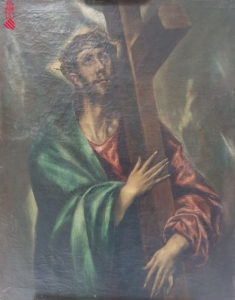The pandemic has been an interesting period to study. With nearly everyone abiding by the prescribed public health measures for nearly two years, not only have our lives clearly changed, but the processes that govern our lives have changed as well; the way we work, the way we shop, the way we educate our children, even the way we commit crimes. While crime as a whole has decreased, an Interpol report from last month revealed that many forms of crime related to art and cultural property have skyrocketed. Across 72 countries in 2020 alone, the amount of contraband art seized by law enforcement nearly doubled in the Americas and increased by about 23% in Europe. Though the increase in Europe was nowhere near as large as in the Americas, about two-thirds of the over 800,000 objects seized from traffickers and smugglers were confiscated in Europe, which only goes to show how much stolen art is sent to Europe in a relatively normal year.
Looting and illegal excavations have also increased. While digs in Africa increased by 32% last year, similar digs in the Americas rose by 187%. But that is nothing compared to the increase in looting in Asia and the Pacific, which increased thirty-eight times from the previous year. Since nearly all museums were closed for much of 2020, it is not surprising that museum crimes have plummeted. The only notable exceptions to this overall trend were the theft of a Van Gogh painting from a museum in the Dutch town of Laren, and the theft of three pieces from a gallery in Oxford, UK, both in March of last year. But just because crime in museums was down doesn’t mean all went well for those institutions. Because of the closures, nonprofit arts organizations have seen 40% decreases in overall income, or about $5 billion in losses.
It seems that international law enforcement has banded together to adapt to the changing trends in art-related crimes. For example, the European Union Agency for Law Enforcement Cooperation (Europol) and the World Customs Organization carried out joint operations that targeted cartels of art traffickers operating in 103 countries. So far, these collaborative undertakings have recovered over 19,000 objects. But nowadays, some forgers and smugglers operate in a strangely open and public way to the point that it becomes indistinguishable from a comedy sketch. Over the past year or two, the Antiquities Trafficking and Heritage Anthropology Research Project (ATHAR) has reported that one of the main ways groups engaged in looting and smuggling keep in contact is through, of all things, Facebook groups. ATHAR’s Twitter account has posted screenshots of particular Facebook groups, with members numbering in the hundreds of thousands, where smugglers and looters share pictures and videos of looted items. It’s absolutely inconceivable that some smuggling operations are difficult to prevent when the masterminds behind them use the same communications techniques as suburban housewives involved in MLMs.
The pandemic has also seen its fair share of forgery stories. Over the summer, Angel Pereda was arrested for wire fraud relating to several forged works that he claimed were by Jean-Michel Basquiat and Keith Haring. He now faces up to twenty years in prison for trying to sell these forged works at auction houses in New York. The Haring fakes, one painting, and one vase, were uncovered thanks to evaluations done by the Keith Haring Foundation. Regarding the fake Basquiat painting, experts were tipped off about the dubious origins of the work because of questionable provenance documents. If the Basquiat were authentic, it would hypothetically be worth around $6 million.
Francis Bacon has also been getting some attention, with accusations of forgery aimed at multiple, unconnected people. This year, Bacon’s estate published a book of his studies, in which his friend Barry Joule is accused of passing off his own sketches as those of Bacon. Because of this claim, the works Joule provided to the Tate in London have been taken down, much to Joule’s chagrin. At the same time, in an unconnected incident, nearly 500 Francis Bacon forgeries were confiscated by Italian authorities in September. Had the works been genuine, this collection would have been worth €3 million. An investigation uncovered a conspiracy consisting of five people who intended to provide false authentications for the works and then sell them. The apparent mastermind behind the scheme, a man from Bologna, had previously been investigated for trying to sell forged Picasso works. Other 20th century artists, including Raymond Pettibon, Richard Hambleton, and Barkley Henricks, had their works forged and sold during the pandemic. Even Old Masters like Francisco de Goya and El Greco were not spared. However, we are not sure if instances of art forgery have legitimately increased, or if their coverage has simply become a more frequent subject for news sites.
This pandemic is one of those once-in-a-lifetime periods that radically changed certain aspects of our lives, much in the same way that Watergate or the First World War served as similar junctures. Law enforcement and the scholarly community may have to seriously reconsider how smuggling and forging are prevented and detected due to the new realities of the pandemic that we’ve all grown accustomed to.


